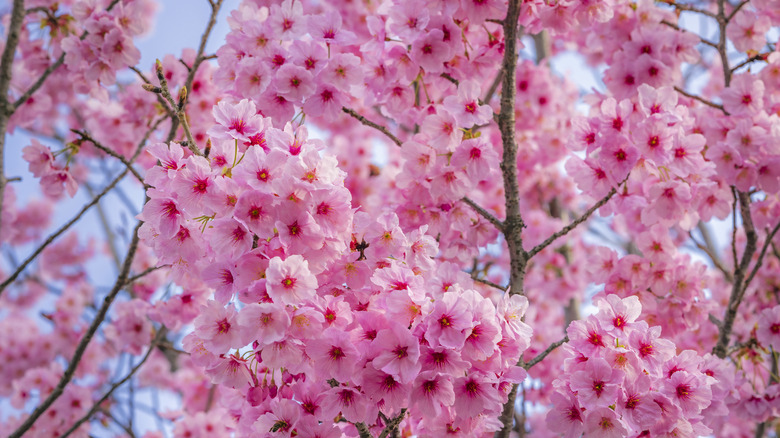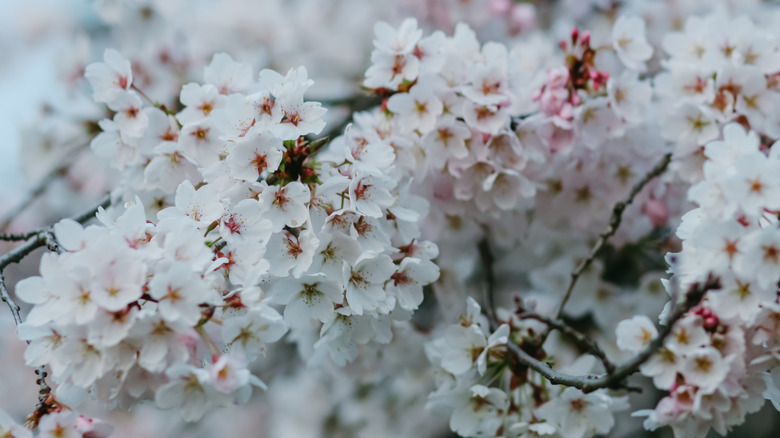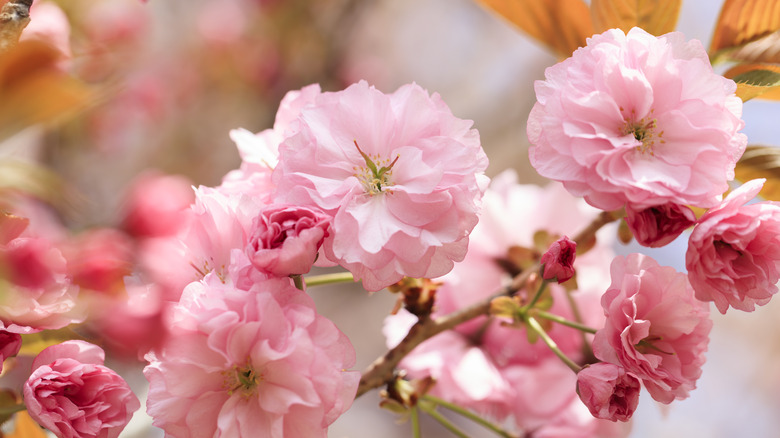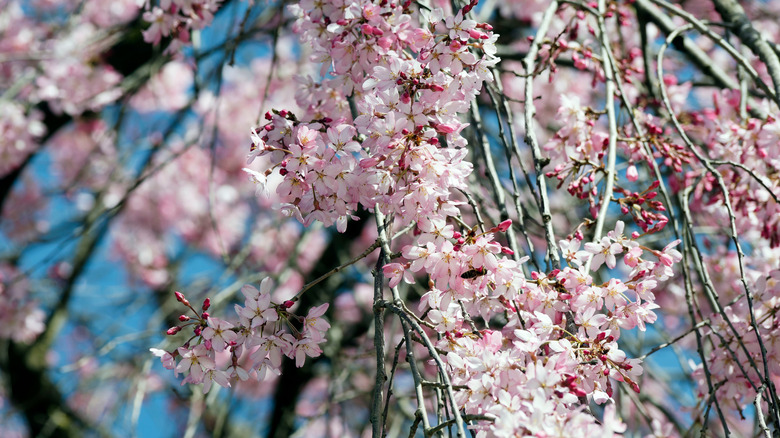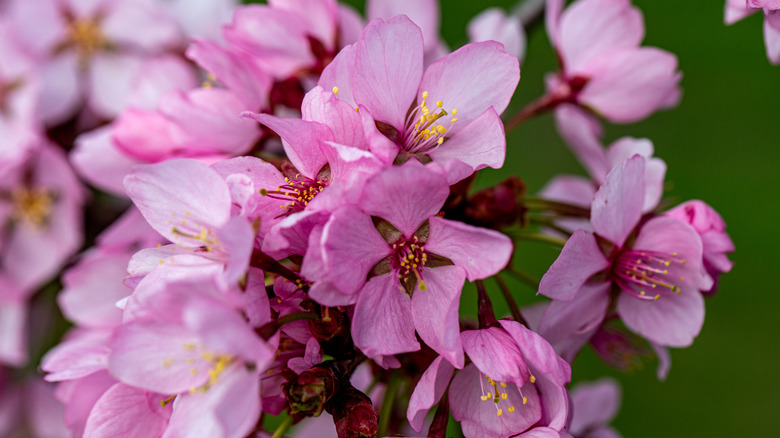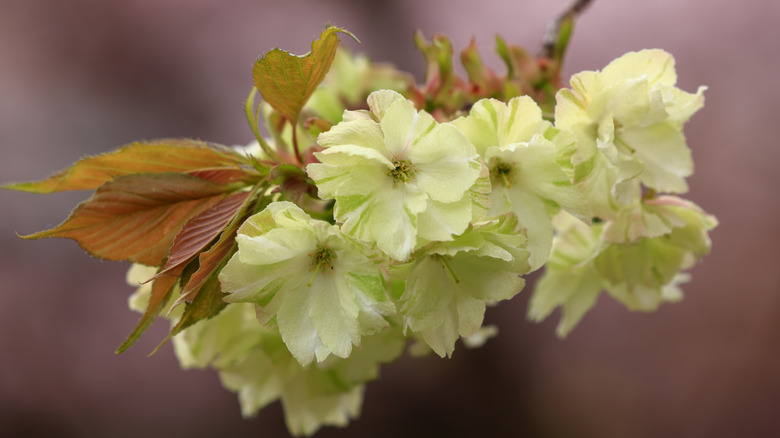5 Varieties Of Cherry Blossom Trees That Can Add Gorgeous Color To A Garden
There are few images more iconic than that of a Japanese cherry tree, or sakura, in full springtime bloom — delicate, pink-tinged blossoms, loose petals drifting gently on the breeze. There are hundreds of varieties of flowering tree that fall under the category of "Japanese flowering cherries," which is a sort of umbrella term generally understood to include cultivars of Prunus serrulata, Higan cherry (Prunus subhirtella), and Yoshino cherry (Prunus × yedoensis), among others. Although a fundamental part of Japanese horticulture for centuries, these flowering cherries are a relatively new arrival on U.S. shores, with varieties just starting to appear in gardens around the late 19th century.
These trees typically feature five-petaled blossoms, though some types — referred to as "yaezakura" — have more, ranging from ten to nearly a hundred petals. Native to parts of Japan, China, and Korea, Japanese flowering cherries tend to be relatively short-lived, with a lifespan of 20 years or so, and can be a bit of a challenge due to their susceptibility to pests, diseases, and other issues. But if you're determined to bring the beauty of these flowering trees to your yard, as well as committed to their care, there are many gorgeous varieties on the list of Japanese trees that you might explore.
Yoshino
Among the most prevalent varieties of cherry trees in Japan, the Yoshino cherry, or Somei Yoshino (Prunus x yedoensis), is also one of the more commonly planted cultivars in the U.S. Its five-petaled blossoms are mostly white, sometimes tinged with pink. Its profuse blooming is an early spring spectacle, either just before or just as its foliage begins to return. Once the blossoms drop, it produces small black fruits that birds love. It's hardy in USDA Zones 5 through 8 and resistant to heat and humidity, though unfortunately deer tend to enjoy munching on it, as do insect pests.
Kanzan
A common yaezakura varieties, the 'Kanzan' (Prunus serrulata 'Kanzan'), produces dramatic clusters of deep pink blossoms with 20 to 30 petals arranged in two layers in April — either just before or simultaneous with the emergence of new bronze-green leaves. Suited to zones 5 through 9, it's one of the hardier yaezakura types and may even be a bit more cold-hardy than other Japanese cherries. It's able to tolerate down to -20 degrees Fahrenheit – though unfortunately it isn't among the most disease-resistant flowering trees. In the fall, its leaves take on a lovely yellow hue.
Higan
You may have seen the "weeping" version of the Higan cherry (Prunus × subhirtella) sold in stores, though often this is actually branches from 'Pendula' cultivar grafted onto some other straight-trunked cherry rootstock. Another widely utilized cultivar of this naturally-occurring hybrid is 'Autumnalis,' an upright version with double-layered pink blossoms. Higan cherries are among the longer-lived Japanese cherries — just make sure you're sourcing them from a reputable retailer, as the commonly available grafted version can be a bit weaker. Suited to zones 4 through 8, they can grow in part shade but will produce their best flowers in the sun.
O-yama-zakura
The O-yama-zakura or "big mountain cherry" (Prunus sargentii), known as Sargent's cherry, is a somewhat rarer northern species that is cold hardy and comparatively pest-resistant. It features bright pink flowers with five petals, and its fresh leaves boast a unique coppery purple appearance. They change to dark green as they mature before turning orange or red in the autumn. It's hardy in zones 4 through 7 and tolerant of some shade and high wind, though, unlike some other Japanese cherries, it can get a bit unhappy in high heat and humidity. It can live for up to 50 years.
Ukon
Maybe pink isn't your gig — not to worry, the 'Ukon' cultivar of Prunus serrulata delivers an unusual, eye-catching pale yellow instead! In fact, "ukon" translates to "turmeric" in Japanese, a reference to the spice's tendency to stain surfaces yellow. A double-layered blossom variety whose flowers resemble tiny roses, its coppery leaves appear with (rather than after) the blooming season. 'Ukon' is fairly hardy and disease-resistant for a Japanese cherry, appropriate for zones 5 through 8, and will produce its best and more numerous blooms in full sun. It likes moist, well-drained soil but won't do well in soggy settings.
